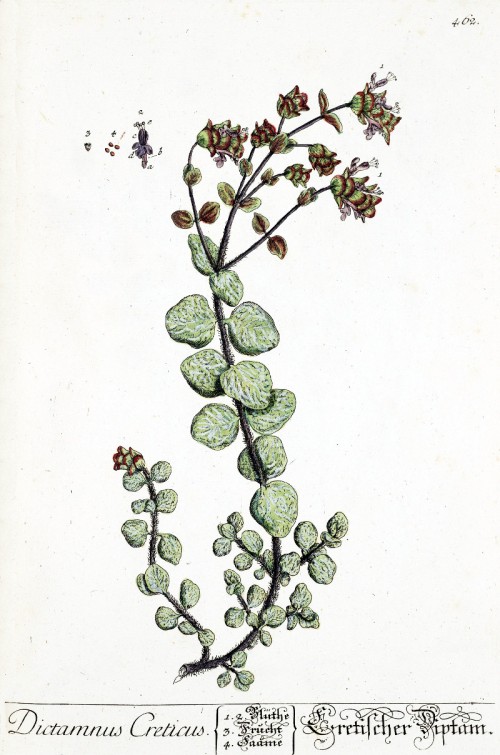Origanum dictamnus L. - Lamiaceae - Δίκταμο (greek), Cretan dittany, Kretischer Diptam, Diptam-Dost
Dwarf shrub, up to 20cm high, endemic to the Greek island of Crete; stems (branched at the base) and leaves woolly covered by fluffy hairs; leaves young reddish. later green; flowers rose-pink, with closely overlapping purple bracts. „Conservation status (for threatened species): Vulnerable according to the Red Data Book of Rare and Threatened Plants of Greece (1995).“
http://www.cretanflora.com/origanum_dictamnus.html
„In Minoan Crete and ancient Greece dittany was one of the most important medicinal plants. Hippocrates used it against diseases of the stomach and digestive system, for rheumatism and arthritis, as emmenagogue, tonic and antispasmodic.“ https://el.wikipedia.org/wiki/%CE%94%CE%AF%CE%BA%CF%84%CE%B1%CE%BC%CE%BF
„Oregano, sweet majoram and dittany are mainly used to treat bronchitis, catarrh, cold and flu, colic and dyspepsia. These herbs or their dilute oils are sometimes used topically for mouth hygiene, to treat nasal congestion, wounds and itching skin.“
[Medicinal Plants of the World. Ben-Erik Van Wyk and Michael Wink, Pretoria 2004, 221]
„Origanum dictamnus (Lamiaceae family), an endemic plant of the Greek island of Crete, is widely used as a traditional medicine since antiquity… An increasing number of chemical and pharmacological studies have been reported recently, some of which strongly support its traditional medicinal uses against various illnesses such as sore throat, cough and gastric ulcer. A variety of compounds, including flavonoids, lipids and terpenoids (mainly carvacrol and thymol) have been identified from the plant. Current studies have showed that the extracts, the essential oil, as well as their active principles possess several pharmacological properties, like antimicrobial, antioxidant and anti-ulcer ones.“
[Dittany of Crete: A botanical and ethnopharmacological review. Christos C. Liolios, Konstantia Graikou, Eleni Skaltsa, Ioanna Chinou, Journal of Ethnopharmacology, Vol.131(2), 2010, 229–241]
„The essential oil of Origanum dictamnus L. was obtained by steam distillation with a yield of 0.8% of dry material. The oil was investigated after fractionation on a silica gel column and separation of phenols, by combination of GLC-mass spectrometry. In the analysis, 30 components were found accounting for 98.28% of the oil, the predominating compounds being carvacrol, γ-terpinene, p-cymene, caryophyllene, borneol, terpin-1-en-4-ol, and carvacrol methyl ether.“
[Essential Oil from Origanum dictamnus. Harvala, C., P. Menounos, and N. Argyriadou., Planta medica Vol.53(1) 1987, 107-109]
„The basic flavour of Dittany of Crete is strong, sharp and slightly bitter balancing between oregano-like (mainly due to carvacrol) or thyme-like (due to thymol) nuance… If Cretan Dittany is successfully promoted as a food ingredient (or a possible functional food) to be launched in easily made dishes of everyday life and in nouvelle cuisine preparations, it could soon be considered as a high value-added product which can offer potential to the sustainable development at local scale.“
[Introducing Dittany of Crete (Origanum dictamnus L.) to gastronomy: A new culinary concept for a traditionally used medicinal plant., Krigas, N., Lazari, D., Maloupa, E., Stikoudi, M., International Journal of Gastronomy and Food Science, 2(2), 2015, 112-118] http://www.sciencedirect.com/science/article/pii/S1878450X15000049

Blackwell,E., Herbarium Blackwellianum, vol.5 t.462 (1765)
http://plantgenera.org/species.php?id_species=724389
